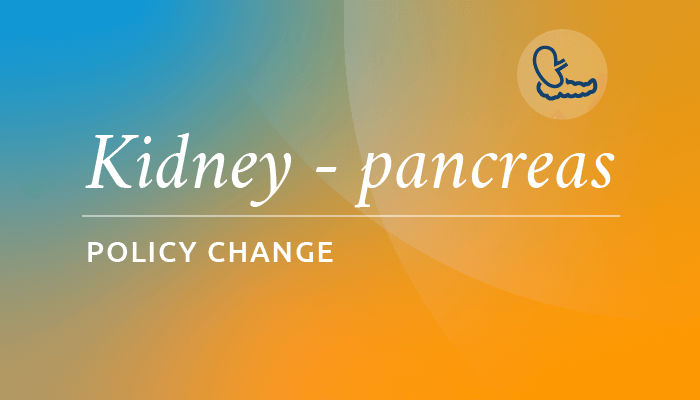On Dec. 15, 2020, the to remove donation service area (DSA) and OPTN region from kidney and pancreas allocation. At implementation, DSA and region will be replaced with a 250 nautical mile (NM) fixed circle.
These changes to kidney and pancreas allocation were developed as a result of the OPTN Board of Directors’ 2018 directive that organ-specific committees remove DSA and region from allocation policies to align with the OPTN Final Rule. One of the requirements of the Final Rule is that policies “shall not be based on the candidate’s place of residence or place of listing, except to the extent required” by other requirements of the Rule.
Increasing equity in access is a strategic goal of United Network for Organ Sharing, and statistical simulation modeling projects that the new kidney and pancreas policies will improve transplant access for key groups of transplant candidates, including children, women, ethnic minorities and highly-sensitized candidates.
Changes to released organ allocation
The new released organ allocation policies address the reallocation of kidney, kidney-pancreas, pancreas, and islets in situations in which an organ allocated to an original intended recipient is unable to be transplanted in that recipient. For released kidneys, the major change will be that the host OPO will maintain responsibility for any necessary continued allocation either using the original match run or a new match run with a 250NM circle around the intended recipient hospital. The allocation of released kidneys will no longer be done at the importing OPO or DSA level. Find a visual aid of the host OPO released organ processes for reallocating kidney, pancreas and kidney-pancreas here.
Two phases of implementation for new medical urgency requirements for kidney candidates
In order to provide a consistent definition of medical urgency and to ensure medically urgent kidney candidates receive allocation priority in the new system, a new policy creates newly defined medical urgency classifications within all kidney allocation sequences. More details, including a table of what this means for Sequences A-D, may be found on the policy toolkit page.
There will be two phases of implementation for the medical urgency policy:
- Phase I is a transition period that begins Dec. 1, 14 days prior to the policy going live on Dec. 15. Transplant program staff should pre-fill data early for any candidates who will meet the new definition of medically urgent. This will allow their candidates to receive priority at the new status as soon as the new policy is implemented. During Phase I, candidates won’t accrue waiting time at the new medically urgent status or receive priority based on this criteria.
- Phase II begins Dec. 15, the day the policy is implemented. At that time, all candidates with pending medical urgency data pre-filled during Phase I will be automatically converted to the new medically urgent status (Status 2).If current candidate listings that have existing medically urgent and critical statuses (Status 5 and Status 6) are not updated with new medical urgency qualifying data by Dec. 15, they will convert to active status (Status 1). Status 5 and 6 will no longer be exist as options when listing kidney candidates.
Professional education offerings available in November
Resources and trainings for organ procurement and transplant professionals are in development. The following online educational modules will launch in November on UNOS Connect:
- Nov. 3: KID113 Medically Urgent Status for Adult and Pediatric Candidates: Phase One
- Nov. 17: KID112 Removing DSA and Region from Kidney and Pancreas Allocation
- Nov. 17: KID114 Medically Urgent Status for Adult and Pediatric Candidates: Phase Two
- Nov. 17: KID111 Modifications to Released Kidney and Pancreas Allocation
- Nov. 17: QLT102D Notification Limits for Distance-based Allocation
- Nov. 17: QLT103D Acceptance Criteria for Distance-based Allocation
Policy toolkits
More information about the changes involved with these policies can be found in the Professional Education section of the OPTN website.
- Removal of DSA and Region from Kidney Allocation Toolkit
- Removal of DSA and Region from Pancreas Allocation Toolkit
- Modifications to Released Kidney and Pancreas Allocation Toolkit
- Addressing Medically Urgent Candidates in the New Kidney Allocation System Toolkit
These toolkit pages will be updated regularly with resources as they are developed. Find answers to some frequently asked questions here. A more detailed FAQ is being prepared.
OPOs may preview the new match lists in a test site
OPOs will have the opportunity to log into a test version of the UNet℠ system to preview the new kidney and kidney-pancreas match lists as well as the new released kidney match type. The test site will be available from Monday, Nov. 2 to Friday, Nov. 13 and will be populated with blinded candidate data. If you are interested in participating in this opportunity, please email the IT project lead, Lauren Motley ([email protected]) for more details. The deadline to request to submit your OPO for participation is Oct. 26.
Do you have questions about these policies and the December implementation?
Please email [email protected]

